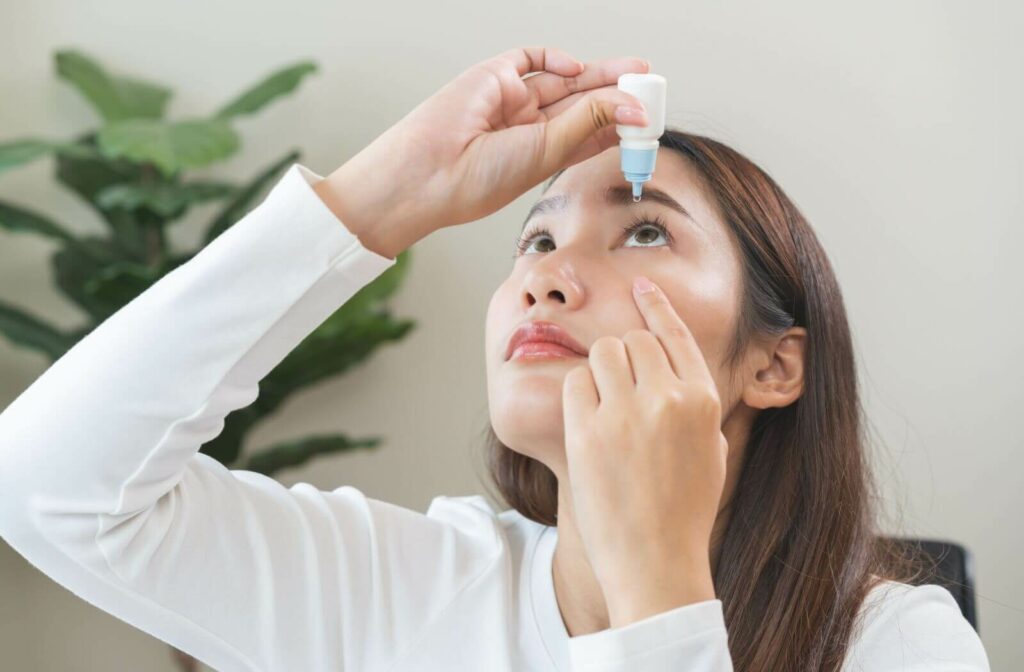When it comes to your health, it’s always best to err on the side of caution.
Expired eye drops are generally not recommended, as they pose health risks and their effectiveness can diminish over time. Understanding the implications of using expired eye drops can help you make informed choices about your eye care.
If you have used expired eye drops and are experiencing adverse reactions such as itching, dryness, tearing, or redness, visit your eye care provider as soon as possible to ensure your vision is protected.
How Do Eye Drops Work?
Eye drops are liquid medications designed to treat various eye conditions. They deliver active ingredients directly to the eye’s surface, providing quick relief from symptoms such as dryness, irritation, or allergies. The formulation can vary depending on the type of eye drop, but most include preservatives to maintain efficacy and stability.
Once applied, eye drops spread across the eye’s surface, penetrating into the tissue and providing the necessary therapeutic effects. However, the effectiveness of these medications can be compromised if the drops are expired, as the active ingredients may break down or change in composition over time.
The Risks of Using Expired Eye Drops
Using expired eye drops can lead to several health risks. The most significant concern is the potential for reduced effectiveness. Expired eye drops may not provide the relief you need, potentially worsening your condition. Additionally, the preservatives in expired products may break down, leading to bacterial growth that can cause infections.
Other risks include:
- Reduced Effectiveness: Active ingredients may break down over time, leading to inadequate treatment.
- Bacterial Growth: Preservatives can degrade, allowing bacteria to proliferate, resulting in eye infections.
- Irritation or Allergic Reactions: Degraded components can cause discomfort and trigger allergic responses.
It’s crucial to assess the expiry date and storage conditions of your eye drops before use.
Types of Eye Drops
Various types of eye drops are designed to address specific conditions. Artificial tears are among the most common, used to relieve dry eyes by providing lubrication. These drops help maintain moisture and comfort, particularly in dry or windy environments.
On the other hand, prescription eye drops are tailored to treat more severe conditions, such as glaucoma or infections. They contain potent medications that require careful administration and monitoring to ensure safety and effectiveness.
- Artificial Tears: Used for dry eyes; provide moisture and relief from irritation.
- Allergy Eye Drops: Contains antihistamines to alleviate allergic reactions, reducing redness and itchiness.
- Prescription Eye Drops: Prescribed for specific conditions; may include antibiotics, anti-inflammatories, or medications to lower intraocular pressure.
Which Eye Drops Are Right for Your Eyes?

Given the numerous options available, choosing the right eye drops can be daunting. It’s essential to consider your specific symptoms and any underlying conditions. For instance, if you frequently experience dry eyes, artificial tears may be the best choice for immediate relief. However, antihistamine drops could be more effective if allergies are your primary concern.
Consulting with an eye care professional can provide valuable insight into which drops are appropriate for your needs. They can help you determine whether over-the-counter options are suitable or if you require a prescription medication for more severe conditions.
Signs You Should Use Eye Drops More Often
Being able to recognize when eye drops might help with an eye condition is important for maintaining your eye health. If you experience persistent dryness, redness, or discomfort, it may be time to incorporate eye drops into your daily routine.
- Persistent Dryness: If your eyes frequently feel dry, artificial tears can provide relief.
- Redness: If your eyes often appear red or irritated, eye drops can help soothe inflammation.
- Contact Lens Use: If you wear contact lenses, you may need to use lubricating drops more often to maintain comfort.
Consistent dryness, grittiness, or tearing could be a sign of dry eye disease.
Do I Have Dry Eyes?
Dry eye is a common condition caused by the inability of the eyes to produce enough tears or the tears evaporating too quickly. This can lead to discomfort, redness, and a gritty eye sensation. Factors contributing to dry eye include environmental conditions, prolonged screen time, and certain medications. Recognizing the symptoms early is essential to prevent further irritation or complications.
Consulting with an eye care professional can provide insights into appropriate treatment options, including the use of lubricating eye drops or lifestyle adjustments. Dry eye is manageable with proper treatment. If eye drops alone don’t provide relief from dry eyes, book an appointment with your eye doctor to determine the underlying cause of your discomfort.
Find Vision Relief with Eye on Evanston
At Eye on Evanston, we understand the importance of maintaining your eye health. Our team is dedicated to providing personalized care and guidance for all your eye care needs.
If you’re unsure which eye drops are right for you, contact us today for a consultation. We’re here to help you find the relief you deserve!





